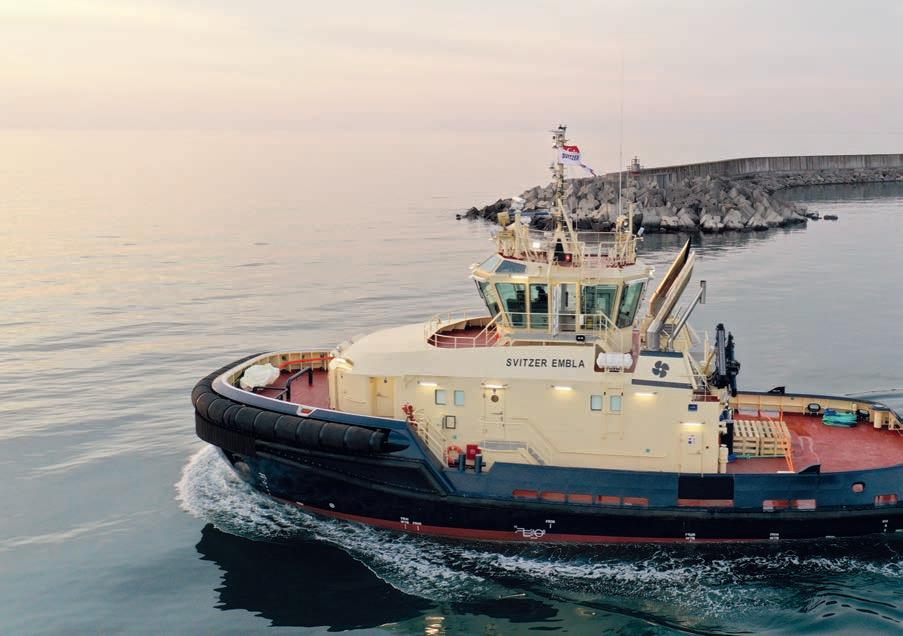
3 minute read
Principles for towage design
30m New ice-class tug Svitzer Embla.
IN SPRING 2021, SVITZER WELCOMES TWO NEW SPECIALLY DESIGNED ICEBREAKING TUGS TO SUPPORT ITS OPERATIONS IN SCANDINAVIA. NEW TWINS EMBLA AND EDDA WILL BOLSTER SVITZER’S CAPABILITIES IN THE REGION.
Advertisement
WORD BY KASPER KARLSEN, CHIEF OPERATING OFFICER OF SVITZER EUROPE. ALL PHOTOS COURTESY OF SVITZER.
These latest tug acquisitons illustrate Svitzer’s primary focus on always having the right tug for the job. Realising this involves careful consideratons about which vessel designs ofer the best service to a specifc port or any customer requirements, while strengthening the ability to be fexible in feet deployment. The enterprise globally operates 440 vessels, of which 130 vessels are pieces in the regional feet planning puzzle in Europe.
Standard or tailored design
When searching for the best tug design, it is critcal for towage operators to assess whether an of-the-shelf opton or a customised design is the best opton to invest in. This consideraton is the central principle for defning how Svitzer scales up its feet capabilites. Given its feet size, there are plenty of factors to consider when it comes to tug acquisitons. Tugs will likely move around the company’s network and will need to adapt to diferent operatons and customer demands. While tailored designs meet the requests for special capabilites, standard designs also serve an important purpose. An of-the-shelf harbour tug can be a completely reasonable investment for ports with multple customers. Consideratons should then focus on the vessel’s strength and propulsion system.
Revolutionary builds
Svitzer recently took delivery of Svitzer Thames, a somewhat standard 80t bollard pull ASD tug that is a perfect asset for the variety of jobs we see in a diverse port like London. However, operatons with special requirements or ports and customers with specifc demands – such as the Scandinavian waters with seasonal ice and therefore the demand for ice-breaking capabilites – call for customised builds. Each special design is treated as a separate research and development project that stretches the company team’s expertse to



build something revolutonary and customer focused. Some innovatons are small, others are huge. The enterprise’s innovaton team collaborates with naval architects and shipyards on modifying vessel layout, propulsion systems, and engine power, and aims to improve each vessel’s performance, efciency, and sustainability credentals.
Moving the needle
The people at Svitzer are currently working on a custom soluton for the Recotug project. Advanced autonomy will play a bigger role in the future and the company is determined to be at the forefront of this innovaton. Its mission is to explore how automated equipment and advanced autonomous technology can improve both safety and efciency, hereby strengthening the enterprise’s value propositon to customers. Considering all aspects of tug design, Svitzer wants to move the needle and diferentate itself by partnering up with the best designers to bring innovatve, efcient, and forward-looking new tugs to the market. When designing, the company always keeps its biggest asset in mind: the crew. Regarding the new icebreakers, the design yields a safe and pleasant working environment for those aboard. The tugs are equipped with the Svitzer Catcher, an automated tying mechanism that excepts substantal risk elements when the tug connects to the assisted ship. The winch is fully enclosed in a garage to protect the mechanics and those working on deck. The same winch can be used as a towing winch over the stern, with the tow wire passing in a trunk under the superstructure, a simple and innovatve feature creatng a required capability without adding any signifcant mechanical complexites.
New ice-class tug Svitzer Edda
80t bollard pull ASD tug Svitzer Thames.
Regulations
Regulatons obviously play an important part in forward-looking design practces. For example, the IMO recently imposed regulatons for all new vessels operatng in the North Sea and Baltc Sea – where Svitzer’s presence is quite signifcant – to follow Tier III NOx emissions requirements. The company wants to ensure that all new tugs comply, regardless of whether they will initally operate outside of regulated areas. The aforementoned principles help Svitzer to defne decisions regarding new additons to its global feet. Adding Svitzer Embla and Svitzer Edda is typical for the enterprise’s approach of making the right decisions to innovate and support customer requirements. By doing so, Svitzer certainly plays its part in realising progressive feet utlisaton and vessel design in its segment.










